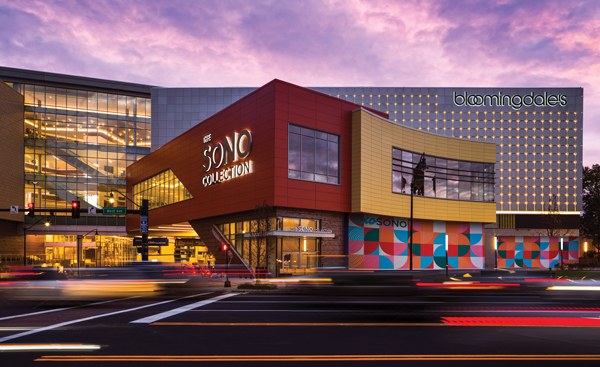Trending
All eyes are on the last new mall of the Northeast: Norwalk’s SoNo Collection

After more than five years of development, and much fanfare and nail-biting along the way, Brookfield Properties’ SoNo Collection opened in October in Norwalk, Connecticut.
To say that a mall launch in 2019 is unusual would be quite the understatement. SoNo’s opening defies current market wisdom regarding the precarious nature of the retail sector. Malls are shrinking their footprints, and it’s been a record-breaking year for store closings, according to U.S. retail tracker Coresight Research.
Last year, about 6,000 stores closed. More than 12,000 are expected to close by the end of 2019. Major chains like Forever 21 have announced bankruptcy this year, and investors are looking to replace shopping centers with other assets for the health of their portfolios.
With SoNo, Brookfield has modernized some elements of the shopping center concept, but some say it’s the part of a dying breed.
“This is probably the last traditional model we’re going to see in the Northeast,” said Kim Galton, director of retail at Houlihan Lawrence Commercial Group, which is based in nearby Westchester County.
Brookfield, for one, partially cashed out, selling 80 percent of its stake in the shopping center for $304 million in early November, according to reports. The total price of the deal was $419 million, which includes shares owned by other investors, and the company will use the money for future projects. Brookfield did not respond to The Real Deal’s requests for comment on the sale.
Landlords and local real estate professionals alike hope the SoNo Collection will be an exception to the “retail is dead” narrative. Sources said the mall appeared to be only “half-activated” at the beginning of November, but Brookfield said the space is 90 percent leased and stores will continue opening through early 2020.
Anchored by Nordstrom and Bloomingdale’s, the three-story mall offers street-level dining, eight stories of parking, outdoor spaces and a permanent art installation. It also boasts Amazon’s first brick-and-mortar retail outlet in the state as well as several other stores whose brands launched online first, including Casper mattresses and Untuckit, a men’s shirt shop. A number of the collection’s 70-plus stores, including Bloomingdale’s, opened up just before the holiday rush, according to Matt Seebeck, the senior general manager of the SoNo Collection.
 Seebeck said Brookfield has adapted the shopping center for today’s customers by reducing its size to just over 700,000 square feet and adding amenities like a rooftop garden and rotating art exhibitions. In addition, it has eliminated the food court frequented by so many teenagers in decades past, opting for restaurants on the street level that are more integrated with the community. There are also fast-casual stands on the third floor, he added, but declined to comment on leasing rates.
Seebeck said Brookfield has adapted the shopping center for today’s customers by reducing its size to just over 700,000 square feet and adding amenities like a rooftop garden and rotating art exhibitions. In addition, it has eliminated the food court frequented by so many teenagers in decades past, opting for restaurants on the street level that are more integrated with the community. There are also fast-casual stands on the third floor, he added, but declined to comment on leasing rates.
Backers say SoNo’s location, at the busy intersection of I-95 and Route 7 in Norwalk, inviting atmosphere and tenant mix will attract customers.
But other developers aren’t so sure about the future of malls.
For example, the 853,000-square-foot Stamford Town Center was listed for sale in October by owner Taubman Centers, the shopping center real estate investment trust.
“As the retail evolution continues, we are exploring all possible alternatives for the asset, including a sale,” Taubman’s director of strategic communications, Maria Mainville, told Westfair Online at the time. The asking price was unclear, but the property is represented by Eastdil Secured.
Some local retail centers have morphed into other types of projects. Take Steelpointe Harbor in Bridgeport, which started off 18 years ago with plans to become a retail destination. It’s now more of a waterfront community with restaurants, planned residential space and, to a lesser extent, retail.
An uncertain future
As big-box chains continue to close, the local retail environment has dealt with the uncertainty relatively well. The retail vacancy rate was 4.5 percent in the second quarter in Fairfield and New Haven counties, according to a report by Institutional Property Investors.
“Retail is adjusting to a changing market,” Galton said. “But there are pockets of businesses that are performing well.”
Deals aren’t being made as fast as they were 10 or more years ago, but they are being made, said Jason Wuchiski, executive director and partner at True Commercial Real Estate, based in Westport. Retailers have many choices and are holding out for the best of the spaces available to them.
“Retailers are still in an opportunistic mode,” Wuchiski said.

And landlords are looking for a sure thing. Wellness is a buzzword across all sectors of real estate, and retail is no exception. To that end, gyms and boutique fitness centers are opening locations throughout Fairfield County, Galton noted.
Training studio F45 just recently opened in Stamford, and there’s a new Row House in Westport, Galton noted. There are new yoga studios in many towns, and boutique fitness center chain Orangetheory now has eight studios in Fairfield County.
Kumon and Code Ninjas, which offer classes in computer programming for children, are also taking up space in affluent areas, Galton added. And restaurants have been key to revitalizing retail areas, including Greenwich Avenue, the main thoroughfare in tony Greenwich, Galton explained.
“There are some notable new openings of restaurants that are really making it a more vibrant street again,” she said.
On the other hand, Greenwich Avenue has large retail spaces that have been sitting empty for years, according to Wuchiski.
“There’s not a ton going on [in Greenwich] right now, that’s for sure,” he said. “We’ve got some space there that we can’t give away, but Greenwich Avenue has always kind of been a roller coaster, with ups and downs.”
Wuchiski noted that certain retailers, like Saks Fifth Avenue, have weathered the storm. But there have been a lot of closings there in the last five years, from Ralph Lauren to Cole Haan. And rents “have corrected themselves.”
“You could see deals at 175 bucks a foot at one point, and now that’s not going to happen,” he said. “Now you’re back down to $100. You can even find some sub-$100 deals on the avenue now.”
Westport’s Main Street is faring better, he added. Women’s apparel store Johnny Was is set to open there in March 2020, and Robert Redford’s Sundance is planning on opening early next year in a 3,920-square-foot space at 69 Main Street. Lululemon Athletica will also move its store to that address from another spot on Main Street, thus doubling its footprint there.
Despite those deals, Wuchiski said retailers that might consider Greenwich Avenue and Main Street are holding off.
“A lot of retailers want to see what happens with the SoNo Collection,” he said.




